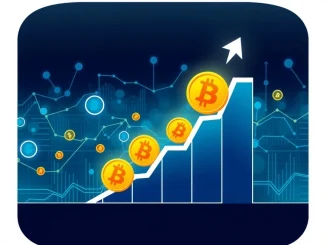
Big news in the crypto world! A significant development is underway that connects the power of Bitcoin with the flexibility of Ethereum’s restaking ecosystem. The Lombard EigenLayer integration is set to open up new opportunities for users holding wrapped Bitcoin.
Understanding Bitcoin Restaking and LBTC
Traditionally, Bitcoin’s utility has been primarily as a store of value and a medium of exchange on its native blockchain. However, recent innovations are changing this. Bitcoin restaking is an emerging concept that aims to leverage Bitcoin’s security and capital outside its own network, often on other blockchains like Ethereum or through specific protocols like Babylon.
Lombard is a platform focused on bringing Bitcoin’s value into this new paradigm. They have developed LBTC, a form of wrapped Bitcoin designed to be compatible with other ecosystems. The goal is to allow Bitcoin holders to earn yield or contribute to the security of other networks without selling their BTC.
How the EigenLayer Restaking Ecosystem Works
On the other side of this integration is EigenLayer. This protocol, built on Ethereum, has pioneered the concept of EigenLayer restaking. It allows users who have staked ETH (or Liquid Staking Tokens representing staked ETH) to ‘restake’ their assets to help secure other decentralized services, known as Actively Validated Services (AVSs). In return, restakers can earn additional rewards from these AVSs, creating a new layer of yield opportunities on top of standard ETH staking.
EigenLayer significantly expands the utility of staked ETH, allowing it to contribute to the security and decentralization of a wider range of applications beyond just the Ethereum consensus layer.
The Lombard EigenLayer Integration Explained
The core of this announcement is that Lombard is integrating its wrapped Bitcoin, LBTC, directly into the EigenLayer ecosystem. This collaboration involves the EigenLayer Foundation, the developer behind the protocol. What this means in practice is that LBTC is becoming a recognized asset within the EigenLayer framework, enabling it to be restaked alongside ETH and LSTs.
This move bridges two major ecosystems: Bitcoin and Ethereum. By bringing LBTC into EigenLayer, Lombard is facilitating a way for Bitcoin’s value to participate in the rapidly growing Ethereum restaking landscape.
Unlocking Dual Restaking Rewards: A Game Changer?
Perhaps the most exciting aspect of this integration, as highlighted in a report by The Block, is the potential for users to receive dual restaking rewards. This implies that users who restake LBTC through this integration could potentially earn rewards from *both* the Babylon protocol (which focuses on Bitcoin-native staking/restaking) *and* the EigenLayer ecosystem (from the AVSs they secure).
This possibility represents a significant potential increase in yield generation for Bitcoin holders compared to traditional methods or even single-protocol restaking. It leverages the strengths of two different restaking paradigms simultaneously.
What are the Potential Benefits?
- Increased Yield: Earning rewards from two distinct restaking protocols simultaneously.
- Enhanced Utility for LBTC: Providing a new, high-yield use case for Lombard’s wrapped Bitcoin.
- Bridging Ecosystems: Further connecting the Bitcoin and Ethereum networks, fostering cross-chain collaboration.
- Expanding EigenLayer: Bringing a major asset class (Bitcoin) into the EigenLayer restaking pool.
- More Options for BTC Holders: Offering novel ways for Bitcoin holders to earn passive income without selling their BTC.
The Future of LBTC Restaking
The integration of LBTC into EigenLayer is a notable step forward for both platforms and for the broader concept of cross-chain restaking. It validates the idea that assets from one blockchain can securely contribute to the security and economic activity of another.
As the EigenLayer ecosystem matures and more AVSs launch, the opportunities for LBTC restaking are likely to grow. This could potentially increase demand for LBTC and provide a significant channel for Bitcoin capital to flow into decentralized finance applications built on Ethereum and related networks.
Considerations and Next Steps
While the potential is high, users should always consider the associated risks, including smart contract risk, market volatility, and the specific mechanics and slashing conditions of both the Babylon and EigenLayer protocols. It’s important to understand how rewards are distributed and what actions could lead to penalties.
For those interested in participating, the next steps will involve monitoring announcements from Lombard and EigenLayer regarding the specific mechanisms for restaking LBTC and the available opportunities to earn dual rewards.
Conclusion: A New Era for Bitcoin Utility?
The Lombard EigenLayer integration is more than just a technical link; it represents a philosophical shift towards greater interoperability and capital efficiency across blockchains. By enabling dual restaking rewards for LBTC, this development creates compelling incentives for Bitcoin holders to explore opportunities within the Ethereum ecosystem.
As Bitcoin restaking continues to evolve, collaborations like this between Lombard and EigenLayer are paving the way for a future where the world’s largest cryptocurrency plays an increasingly active role in securing and powering decentralized applications far beyond its native chain. This is an exciting development to watch in the evolving landscape of crypto finance.



